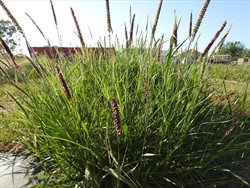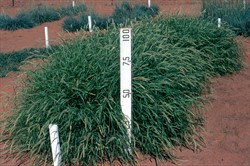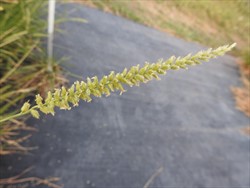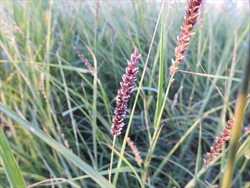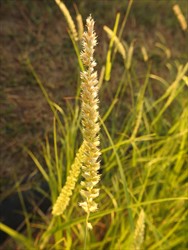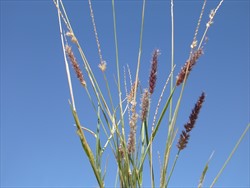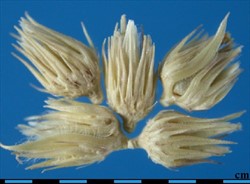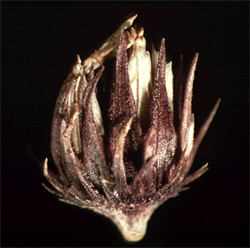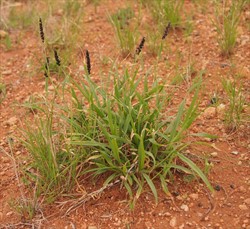Cenchrus setigerus
Tropical Forages
Cenchrus setigerus Vahl
Note: The masculine form of this epithet meaning "bristly", setiger, has been used by some authors and authorities in accordance with classical Latin. However, the name published by Martin Vahl in Enumeratio Plantarum in 1805 was Cenchrus setigerus and the ICN (International Code of Nomenclature for algae, fungi, and plants) does not make specific provision for this change.
Cenchrus montanus Nees ex Steud.; Pennisetum setigerum (Vahl) Wipff
Family: Poaceae (alt. Gramineae) subfamily: Panicoideae tribe: Paniceae subtribe: Cenchrinae.
Tufted, perennial (sometimes behaving as an annual and flowering the first year), non-rhizomatous or shortly rhizomatous with deep root system (to >4 m); culms erect or geniculately ascending 20–60 (–120) cm tall; nodes sometimes brown; butt sheaths sometimes thickened forming a bulb. Leaf blades linear, 15–30 (–45) cm long, and (2–) 4–8 mm wide; surface glabrous or pubescent, sometimes with long scattered hairs on the adaxial surface; ligule a fringe of hairs, 0.6–1.2 mm long. Inflorescence a spiciform panicle (1.5–) 4–10 (–14) cm long and 0.6–0.7 cm wide, green, maturing to light straw-coloured or white (mostly African origin) or dark purple (mostly Indian origin), comprising burr-like seed units (fascicles) inserted along a zig-zag axis. Fascicle broadly oblong with rounded base, 0.3–0.7 cm long; inner bristles to 5 mm long, connate for 1/4–1/2 their length forming a tough cupule, flattened free tips narrowly triangular, erect, antrorsely scaberulous; outer spines very short or almost suppressed, reduced to bristles around periphery of cupule. Caryopsis oblong, dorsally compressed, 1.5 mm long; truncate. 140,000–350,000 seed units/kg; approx. 1 million caryopses/kg.
Similar species
Cenchrus setigerus: inner bristle of fascicle antrorsely barbed/scaberulous.
Cenchrus biflorus: inner bristle of fascicle retrorsely barbed/scaberulous.
Africa: buuyyo harre (Gabra, Kenya); garbi (Somalia); heskaneit (Sudan)
Asia: aebaed (Arabic); darab, sabat (Qatar); cước ven biển (Vietnam)
English: birdwood grass, cow sandbur (English)
Indian subcontinent: anjan, anjan ghash, black kolukattai, cenchrus ghash, garbi, haniteeb, kãlã-dhãman, kata -dhaman, kalanjan, marwar dhaman, moda dhaman, mode dhaman grass, motha dhaman, yaraab, yarrah, yerrah, yerro (India); anjan, dhaman gaa (Pakistan)
Native:
Africa: Egypt; Eritrea; Ethiopia; Kenya; Somalia; Sudan; Tanzania
Asia: India; Iran; Pakistan; Yemen
Naturalized:
Elsewhere in dry tropics and subtropics
Forage
Primarily for permanent pasture. Makes useful hay, but low yields. Valuable standover feed in low-rainfall areas.
Environment
C. setigerus is very resilient, withstanding low and sporadic rainfall, long dry seasons, strong winds, high temperatures, frost, erosion, nutrient-poor soils, and salinity. As such, it has the potential for erosion control in arid and semi-arid land, and rehabilitation of over-exploited desert grasslands.
Other
In some areas it is used as a fuel due to the absence of fuel-wood.
Soil requirements
Adapted to a wider range of soils than is C. ciliaris. While it prefers well-drained, light-textured, sandy soils, it is also found on gravelly areas and alluvial flats, and sometimes on heavy black clays with impeded drainage. However, it rarely grows in stony clay soils or near watercourses. Occurs frequently on alkaline soils. More tolerant of salinity than C. ciliaris.
Moisture
Adapted to arid and semi-arid climates (annual rainfall (125‒) 400‒750 (‒1,250) mm with a long dry season; responds quickly to light rains when temperatures are adequate for growth. More drought-hardy than C. ciliaris. Some ecotypes are found on soils with impeded drainage or seasonally flooded land. Responds well to low-input irrigation.
Temperature
C. setigerus is extremely heat and drought tolerant, but also survives frost. It occurs over a wide latidudinal range from 30⁰ N to 30⁰ S, and from sea level to 500‒800 m asl. Optimum temperature requirement is probably similar to or higher than that for C. ciliaris , with optimum growth from 30 to 35 ºC, but there may be significant differences among ecotypes, particularly with respect to lower temperatures. In Rajasthan in northwest India, growth peaks from August to October. It can regrow through frosted herbage if moisture is adequate.
Light
No record of shade tolerance. While it is found in open dry bush and grassland, this does not necessarily indicate a preference for full light since, by definition, there are few trees or taller species in this habitat.
Reproductive development
An early flowering short day plant. Flowers November to May in the southern hemisphere subtropics, and August-January and again in April in the northern hemisphere. Can grow and set seed freely despite limited rainfall. Flowering can be initiated within 11 days of germination and seed produced within a month, more often 6‒8 weeks.
Defoliation
Once established, withstands grazing well. Best cut every 30 days at about 10 cm. Once established, can stand heavy grazing, even by sheep. Should be allowed to set seed every 2 to 3 years to thicken the stand.
Fire
Fire removes the dry top growth, but plants recover well after rain.
Guidelines for establishment and management of sown forages.
Establishment
Germination can improve for up to 2 years after harvest. Can be aerially sown into ashes or through modified cereal drills into a prepared seedbed. Hand broadcasting is suitable for small areas. For direct seeding, sow at 4–5 kg/ha seed, mixing seed with slightly moist sand, sowing seed 1–2 cm deep or broadcasting when temperatures are around 30 ⁰C, just before or during showers. Seedlings are vigorous and develop quickly.
Fertilizer
Responds to nitrogen and phosphorus. Uneconomical to fertilize in semi-arid and arid areas. Pastures remain productive for many years unless overgrazed.
Compatibility (with other species)
No record, but will always compete for moisture in its normal environment.
Companion species
Grasses: Could be planted with lower-growing Cenchrus ciliaris cvv. American, Gayndah and West Australian.
Legumes: Clitoria ternatea, Desmanthus bicornutus, D. glandulosus, D. leptophyllus, Macroptilium atropurpureum, Stylosanthes hamata, S. humilis, S. scabra, S. seabrana, Vigna aconiitifolia, V. radiata, V. trilobata, Cyamopsis tetragonoloba.
Pests and diseases
No major pests or diseases. Susceptible to cenchrus bunchy shoot (CBS) phytoplasma that, apart from causing a bunchy shoot, also produces deformed heads and stunting.
Ability to spread
Spreads slowly by seed, needing incorporation into the soil by animal treading for establishment.
Weed potential
Considered a serious weed of watercourses in Western Australia.
Nutritive value
Has high feed value during the pre-flowering stage, but much lower during the dry season. 9‒19% CP and 65% IVDMD at early-bloom stage and 40‒50 % IVDMD during the dry season.
Palatability/acceptability
Moderately to highly palatable and readily accepted by all classes of livestock (grazed in preference to Cynodon plectostachyus). A good grass for milking goats in dry environments.
Toxicity
No toxicity reported.
Feedipedia link
Dry matter
Yields (400‒) 1,000‒1,500 (‒3,500) kg/ha DM depending on variety and growing conditions. Grows longer into the season and produces higher yields than C. ciliaris cv. West Australian.
Animal production
In desert areas, carries 1 sheep to 2.5‒6 ha. With fertilizer in semi-arid areas, can raise liveweight gain from 30‒50 kg/ha to 70‒115 kg/ha, and further with mineral supplements.
Pseudogamous apomict (pollination necessary for endosperm formation and seed set). 2n = 4x = 36, and 2n = 54. Rarely 2n = 34, 37. Can hybridize with C. ciliaris. Hexaploids tend to be more vigorous, taller, have more abundant tillers and denser spikes than tetraploids.
C. setigerus has a short day flowering response, and is a prolific seeder. Seed can be hand picked or harvested mechanically with cereal harvesters or special grass-seed harvesters. Unlike C. ciliaris, seed is not fluffy and therefore easier to machine harvest, resulting in annual seed yields of the order of 200‒300 kg/ha. Hand-harvested yields of some lines can reach 600 kg/ha/crop or more, with several crops in a season. Freshly harvested C. setigerus seed has a low germination rate (10–20%) due to germination inhibitors in the involucre. Germination can be improved by soaking the seed for 8–12 hours before sowing or keeping the seed under suitable storage conditions for 12 months or more to remove the inhibitors.
No information, but probably similar to those for C. ciliaris:
"Can be controlled using a combination of glyphosate and ammonium sulphate, possibly in repeat applications. Seedlings can be controlled using the grass-selective herbicide, fluazifop-p-butyl or dicamba, 2,4-D, 3,6-dichloropicolinic acid, triclopyr, tebuthiuron, or hexazinone. Older stands, particularly freshly cut material can be at least reduced using hexazinone or tebuthiuron."
- More drought-hardy than C. ciliaris
- Palatable
- Easier to sow than C. ciliaris (non-fluffy seed)
- Quick to respond after rain
- Low production
- Tendency to weediness in some environments
Bogdan, A.V. (1977) Tropical Pasture and Fodder Plants. Longman Inc., New York, USA. p. 75–76.
'Black Kolukattai' Released in India. Developed in Tamil Nadu, a high yielding variety with dark seedhead.
'CAZRI-76': Released in India (1985). Developed by CAZRI, Jodhpur from EC 17655 introduced from Australia. A semi-erect variety attaining a height of usually 50–60 cm.; thin stem with high tillering and brown nodal pigmentation, long and narrow leaves with semi-erect habit.
'Marwar Dhaman' (CAZRI-175) An Institutional collection. Well adapted in arid (Thar Desert) and semi-arid regions of India. Excellent for grazing due to thin stem and leafy foliage.
'Pusa yellow Anjan' Released in India pre-1980.
CPI 17655 (Q 3466). Selected in Australia. Origin Kenya. Very persistent in semi-arid areas.
CAZRI-BH-CS-3, CAZRIBH- CS-4, CAZRI-BH-CS-7, CAZRI-BH-CS-13, CAZRIBH- CS-15, CAZRI-BH-CS-16, CAZRI-BH-CS-17, CAZRIBH- CS-19 and CAZRI-BH-CS-24. Selected in India on the basis of green and dry fodder yield.
